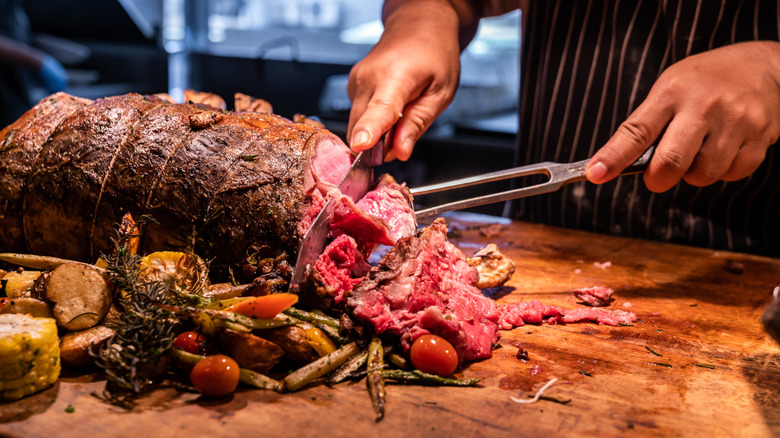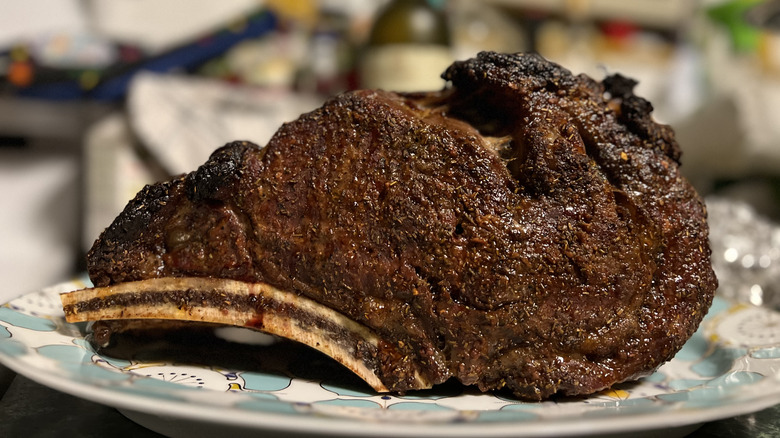Prime Rib Vs Rib Roast: What Sets These Delicious Meats Apart?
If you've ever found yourself scratching your head when the butcher asks whether you want a prime rib or a rib roast to take home for the elaborate holiday dinner you're planning to put together, you're not alone. It's easy to get muddled when you need to pick from so many cuts of steak. Telling apart two nearly identical names doesn't make it any easier. Here's a simple way to remember it: All rib roasts are prime ribs, but not all prime ribs are rib roasts. It's a bit like how all spaghetti is pasta, but not all pasta is spaghetti.
Once you've got that down, the rest starts to make more sense. A cow has 13 ribs. Both rib roast and prime rib come from the rib primal — a large section of beef from the forequarter, located between the chuck and the loin. Rib roasts come from ribs six to 12 in the cow. Prime rib can be cut from any part of the rib primal. However, don't confuse prime rib with USDA Prime. That's a whole different ball game. USDA Prime is a grade, not a cut — it's the label the U.S. Department of Agriculture gives to the highest-quality beef based on marbling and age.
What is prime rib?
To give you a little more perspective on the difference between prime rib and a rib roast, a ribeye is sliced from the prime rib, and a butcher is usually able to cut out three to seven steaks from this area. Just like a prime rib can be a part of the rib roast, a ribeye is a portion of the prime rib. While the terms aren't interchangeable, no one's going to throw you in jail for mixing them up, but the difference basically lies in being a part of the whole.
There are a few differences in cooking styles as well. A prime rib roast is usually cooked whole and most often bone-in. A bone-in prime rib is also called a standing rib roast because the meat stands on the bones as it cooks. A perfectly cooked prime rib has long been a holiday centerpiece. Since it's roasted whole, it requires a longer, slower cook. That also makes it slightly more affordable than a rib roast (though not always), as there's less prep involved on the butcher's end. Though, you can always opt for a boneless prime rib, or ask your butcher to portion it.
If you're planning to cook a prime rib roast, it's worth seeking out one that's actually graded Prime. Avoid going for a discounted option, which is a common mistake people make while cooking a prime roast. Sometimes, those markdowns can mean you're getting a lower-quality cut of meat. For a cut that's meant to anchor a special occasion, it's worth prioritizing quality over price.
What is rib roast?
A rib roast is often too large to cook in one piece. Some cuts weigh more than 30 pounds, so it is less likely to be sold as a whole. While a prime rib is usually presented in a single cut, a rib roast can be broken down into many familiar forms. Ribeye steak, a tomahawk, or even back ribs and short ribs all come from the same section of the animal — the rib roast.
The portion around ribs six through nine is considered especially flavorful as it contains a large fat cap and connective tissue. Known as the large-end rib roast or chuck end, this cut can be sold either boneless or bone-in. Because rib roast is most often divided into smaller pieces, it cooks more quickly than prime rib, which requires lower heat and a longer time in the oven. This makes rib roast great for grilling, as it cooks evenly over high heat with the fat basting the meat.


